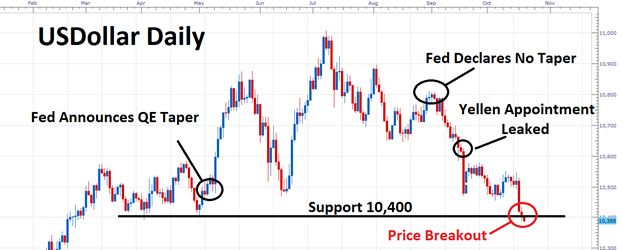The Federal Reserve, better known simply as the Fed, is the central monetary authority in the United States. The Federal Reserve is tasked with a variety of missions but is primarily known for using monetary policy to promote the public interest by attempting to create optimal economic performance. Depending on the actions taken to meet this mission, The Fed also has the ability to influence the valuation of the US Dollar. Today we will review the tools of the Fed and how they can affect currency rates.
MONETARY POLICY AND ASSET PURCHASES
The Federal Reserve divides their U.S. monetary policy tools into three basic components. There is the policy rate, forward guidance and asset purchases. The policy rate and forward guidance have been virtually unchanged since 2008. Rates have been kept near zero in the interest of stimulating the US economy while attempting to control unemployment. With these tools currently being unchanged, traders have primarily been focused on the third Fed tool mentioned above, asset purchases.
Asset purchases refer to the practice of purchasing Treasury and mortgage-backed securities. Currently purchases have increased at the staggering pace of $85 billion per month, and reaching a total of over $3 trillion US Dollars. The Fed has described the logic behind these purchases as an effort to support the US economy through one of the largest economic downturns in current history.
For the 2013 trading speculators have been left wondering when or if these asset purchases will end. So how has the discussion of asset purchases affected the US Dollar?

FED POLICY AND DOLLAR LOWS
The graph above is a daily chart of the Dow Jones FXCM US Dollar Index, which is an equal weighted basket comprised of the EURUSD, GBPUSD, AUDUSD, and USDJPY currency pairs. Here we can see the direct consequences of the Feds action on the price of the US Dollar. The first point marked on the chart denotes statements made by Ben Bernanke in May suggesting that asset purchases may be tapered, or in other words be reduced. Traders took news of a potential taper as a positive sign that the US economy was recovering and within two months of this announcement the US Dollar Index had been bid to new 2013 highs.
However, in just a few short months later traders were given a rude awakening. In September the Fed announced that the taper was to be delayed, due to concerns with the current unemployment rate. The US Dollar immediately began to react by dropping in value! This decline quickly turned into a crater in September when it was prematurely leaked that Janet Yelled was the planned successor of now Federal Reserve Chairman Ben Bernanke. Yellen is expected to continue or even expand the Federal Reserve’s current accommodating monetary policy.
DOLLAR OUTLOOK
Savvy traders aware of the actions of the Fed can directly take advantage of their policies. As we have discussed above, any decrease in the amount of asset purchases is poised to rally the US Dollar. Currently traders should respect that this program of monetary policy, as it is poised to continue even through the selection of a new Fed Chairman. With the US Dollar Index below 10,400, traders can use this as an opportunity to trade Dollar weakness.
= = =
Read another story by Walker England here.
Forex Tools: Trading Oscillators For Active Markets (with video)




